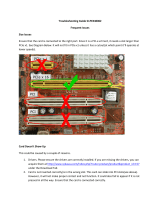
iDRAC Settings Utility..............................................................................................................................................24
Entering The iDRAC Settings Utility..................................................................................................................24
3 Installing Server Module Components.................................................................................. 25
Recommended Tools.............................................................................................................................................. 25
Installing And Removing A Server Module.............................................................................................................25
Removing A Server Module............................................................................................................................. 25
Installing A Server Module...............................................................................................................................27
Opening And Closing The Server Module...............................................................................................................27
Opening The Server Module............................................................................................................................ 27
Closing The Server Module..............................................................................................................................28
Inside The System...................................................................................................................................................28
Cooling Shroud....................................................................................................................................................... 29
Removing The Cooling Shroud......................................................................................................................... 29
Installing The Cooling Shroud.......................................................................................................................... 30
System Memory......................................................................................................................................................30
General Memory Module Installation Guidelines............................................................................................ 32
Mode-Specific Guidelines................................................................................................................................32
PCIe Mezzanine Cards............................................................................................................................................37
Removing A PCIe Mezzanine Card...................................................................................................................37
Installing A PCIe Mezzanine Card....................................................................................................................38
Management Riser Card.........................................................................................................................................39
Replacing The SD Card.................................................................................................................................... 39
Internal USB Key.............................................................................................................................................. 40
SD vFlash Card........................................................................................................................................................41
Replacing The SD vFlash Card......................................................................................................................... 41
Processors..............................................................................................................................................................42
Removing A Processor.....................................................................................................................................42
Installing A Processor......................................................................................................................................44
Hard Drives/SSDs................................................................................................................................................... 45
Hard Drive/SSD Installation Guidelines........................................................................................................... 46
Removing A Hard Drive/SSD............................................................................................................................ 46
Installing A Hard Drive/SSD............................................................................................................................. 47
Shutdown Procedure For Servicing a Hard Drive/SSD....................................................................................47
Configuring The Boot Drive.............................................................................................................................. 47
Removing A Hard Drive/SSD From A Hard-Drive/SSD Carrier.........................................................................47
Installing A Hard Drive/SSD In A Hard-Drive/SSD Carrier...............................................................................48
Hard-Drive/SSD Backplane.................................................................................................................................... 48
Removing The Hard-Drive/SSD Backplane......................................................................................................48
Installing The Hard-Drive/SSD Backplane.......................................................................................................49
System Board..........................................................................................................................................................50
Removing The System Board........................................................................................................................... 50




















